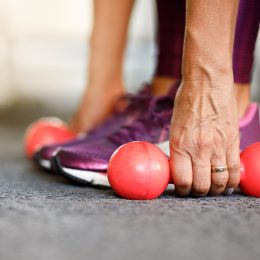4 Health Secrets of Walking
What’s better at keeping the doctor away than an apple a day? Walking. Here are a few of its unsung benefits.

You’ve probably heard the good news about frequent walking: less stress, lower blood pressure, and better blood sugar. But there are additional health benefits that don’t get as many headlines.
“Walking is a highly underrated exercise,” says Layne Nordquist, C.P.T., an area director and master trainer at VASA Fitness in Denver.
In fact, any amount of walking—even five minutes—can give you a health boost, according to the latest fitness guidelines. That’s especially good news for anyone who has never exercised before, wants to lose a significant amount of weight, is managing a health condition, or recovering from an injury.
Over time, the more you can do, the better. Simply put, walking 30 minutes a day on most days of the week is one of the best things you can do for your health.
Ready to get moving? Here are four health secrets of walking that you should know.
Secret #1: Walking Is Powerhouse of a Workout
True, walking can be an easy workout. But as you ramp up speed, intensity, or time, you can also turn up your results.
“The body is amazingly designed and adapts quickly to handle a lot of walking,” Nordquist says. But body changes, he adds, really only occur when you safely push your limits with each workout.
If you have a chronic condition, an injury, or balance issues, start by talking to your doctor about how you can exercise safely.
For beginners, five or 10 minutes of walking is a great start. Make sure you have supportive workout shoes. Look for a safe, comfortable place to walk like a walking path, an indoor track, or a treadmill. If walking on land is too painful, consider walking in a pool.
Take time to figure out your comfort zone, Nordquist recommends. Then train right up against it. For example, if you can comfortably walk 1 mile in 20 minutes, try walking 1.1 miles in that same amount of time the following week.
As you build endurance, your comfort zone will grow—and continuing to challenge yourself will help you see continued results. However, as a general rule, Nordquist recommends increasing your total distance by no more than 10 percent each week. So if you walk 5 miles this week, 5.5 miles is a good goal for next week.
Secret #2: Walking Intervals Can Help You Burn Fat in a Joint-Friendly Way
In the fight against fat, high-intensity interval training (HIIT)—exercise that alternates bouts of all-out effort with easier periods of recovery—beats traditional, steady-paced cardio, Nordquist says.
But a lot of people think that high-intensity exercise has to be high-impact exercise, which tends to be harder on the joints. False. Walking is generally a low-impact activity that can easily take a high-intensity approach.
Here’s how to integrate high-intensity intervals into your walking workouts.
Pick up your pace. Move as fast as you can without breaking into a jog for 30 to 60 seconds.
Taper off. Once you feel like you are working at an 8 on a scale from 1 to 10, with 10 being the hardest, slow your speed until you’re at about 4 or 5.
Ramp back up. Once you’re breathing normally, pick up your pace again.
Inclines are another great way to increase exercise intensity when walking. Adjust the incline on the treadmill, take on a gently sloped hill, or walk up a set of stairs.
For more ideas, check out these fresh ways to kick up your walking workout.
Secret #3: The Best Walking Workout Does Double Duty with Strength Moves
A truly great walking workout don’t involve just walking. Total-body strength exercises can help you have a well-rounded routine, Nordquist says.
Subscribe to our newsletter
It's quick and easy. You could be one of the 13 million people who are eligible.
Already a member? Click to discover our 15,000+ participating locations.
Follow Us
Plus, stronger muscles will give you the oomph you need to push yourself during walks, he adds. Strengthening your legs, hips, core, and even your arms can help you walk faster and farther in everyday life too.
What’s more, sprinkling strength moves into your walks is a great way to increase the difficulty of your workouts. After all, performing bodyweight exercises likes squats or modified pushups in the middle of a walk will work your heart, lungs, and major muscle groups.
Ready to give it a try? Here’s a 30-minute treadmill walk with strength intervals.
Secret #4: Your Most Important Walk Isn’t Your Workout—It’s All the Other Steps You Take in a Day
Those steps you take grocery shopping, cleaning the house, or on an after-dinner stroll with your spouse or neighbor? They add up.
Although your brisk walk on the treadmill might feel like the time you zap the most calories, it’s all the other walking you do in your regular life that can really drive the results you want to see.
More than that, taking more steps throughout your day may extend your lifespan. Sitting for long periods of time increases your risks of early death from any cause, and increases your risk of heart disease, type 2 diabetes, and certain cancers.
Luckily, it’s surprisingly easy to fit in more steps. Check out these 10 ways to sit less and walk more each day.
Take Your Favorite SilverSneakers Classes Online!
SilverSneakers members can access live fitness classes and wellness workshops through SilverSneakers LIVE. See the latest schedule and RSVP for classes here.
Not a member? If you have a Medicare Plan, it may include SilverSneakers—at no additional cost. Check your eligibility instantly here.





